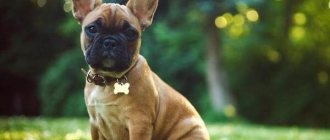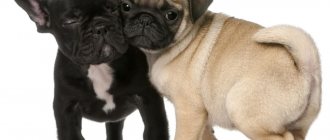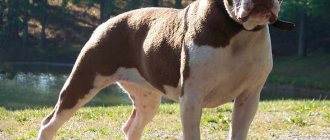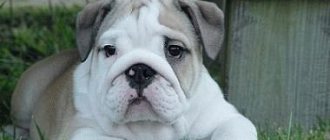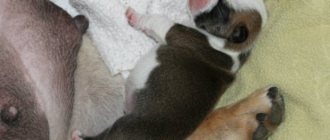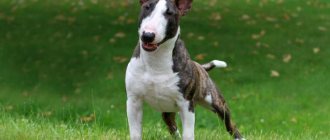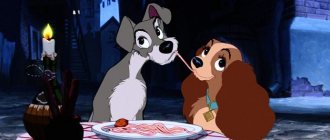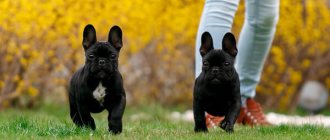Care and maintenance
- The Bulldog is unpretentious, but requires proper nutrition.
- Dogs are prone to obesity and should not be overfed.
- Dogs do not tolerate heat well, so they should not be allowed to overheat. In general, animals are very self-sufficient and do not require constant attention. The bulldog must be given complete freedom of movement: the animal must not be chained, as this will undermine trust in the owner.
- It is better to take the dog with you on long trips, as bulldogs miss their owner and can get sick and refuse food in his absence.
Nutrition
When feeding your bulldog, you need to choose light but nutritious foods so that the dog does not gain excess weight.
The English Bulldog often suffers from allergic reactions, so food from the owner's table will not work. Dry food for dogs of this breed must contain a large amount of protein so that the animal’s muscles develop harmoniously. Only expensive professional food will do; you cannot give your bulldog cheap substitutes, as this will lead to the development of urolithiasis.
Veterinarians believe that it is better to feed this breed with natural products, focusing on the digestive and physiological characteristics of dogs:
- Meat in the diet makes up 40-45%, beef and liver are best, other offal, with the exception of the spleen. Pork or beef ears, raw or smoked, should be given as a treat.
- You can give a bulldog fermented baked milk and kefir. It is better to exclude cheeses from the diet.
- Fish and seafood are contraindicated for a bulldog.
- Suitable cereals include rice or buckwheat. Oatmeal and semolina porridge are too high in calories for dogs. Do not feed your pet baked goods, cookies or candy.
- A dog can have no more than three eggs per week. Both puppies and adult dogs are allowed to give a small amount of cottage cheese.
You can include boiled potatoes and milk in your puppy's diet. The feeding regimen depends on the age of the animal:
- A puppy aged 1-2 months is fed 6 times a day at equal intervals. The night break is 7 hours.
- From 2 to 3 months, the number of feedings is 5, with an interval of 2-3 hours, milk porridge and potatoes are gradually excluded from the diet.
- From 4 months to six months, the number of feedings should be 4, a six-month-old puppy eats three times a day, by 10-12 months of life the dog is considered an adult and should be fed twice: in the morning and in the evening.
Health
The English Bulldog, like any decorative dog, is prone to various diseases and generally has rather fragile health.
- Dogs do not tolerate temperature changes well and are susceptible to colds and heat stroke. It is optimal to keep your pet in a room with a temperature of 20-25 degrees without drafts.
- In hot weather, the dog should be walked in cool, shady places and provided with plenty of fluids.
- Bulldogs love to swallow what they find on the ground and suffer from indigestion problems, so they need to be supervised when walking.
- Another problem for the English Bulldog is difficulty breathing through the nose; dogs suffer from shortness of breath, runny nose and snore in their sleep.
Vaccinations
Bulldog puppies are vaccinated three times - the first time at two months of age, then upon reaching the age of 4-5 months and at one year of age with a polyvalent vaccine.
If symptoms of the disease increase, you should immediately consult a veterinarian. In the future, regular vaccinations will be required once a year with mandatory marks in the dog’s health passport.
Do not vaccinate bitches during estrus and whelping, as well as dogs of both sexes in the presence of another infectious disease.
Diseases
Dogs suffer from an impressive list of diseases:
- Eye diseases - eversion of the eyelids, conjunctivitis, cherry eye syndrome, clouding of the lens, partial or complete loss of vision is possible.
- Heart defects, vascular defects, heart failure.
- Allergic reactions, skin rash.
- Dermatitis between toes and in skin folds.
- Underdevelopment of joints, chronic or habitual dislocation of the elbow.
- Underdevelopment of the genital organs in females, cryptorchidism in males, difficult childbirth.
- Diabetes, obesity, gastric disorders.
- Congenital deafness.
- Urolithiasis disease.
- Diseases of the trachea, nasopharynx.
Proper nutrition and routine will help protect your pet's health, but your bulldog needs to be seen by a veterinarian regularly.
Care and education
Since these are short-haired dogs, grooming is quite simple. To keep the coat clean, the dog must be combed several times a week with a special rubber glove or a brush with stiff, natural bristles. The folds on a bulldog's face need to be cleaned with a damp cotton pad every day to prevent irritation from occurring on the skin. You cannot use soap or shampoo for this. There is no need to bathe your dog often, only when it is very dirty.
In order to remove dirt from the fur, you can simply wipe the dog with a damp cloth. Nails must be trimmed on time to prevent delamination. Teeth should be brushed regularly with a special dog toothpaste. Old English Bulldogs drool constantly, so it is necessary to periodically wipe their face.
Olde English Bulldogs need exercise , this is especially important because of their predisposition to gaining excess weight. However, these dogs do not always want to do exercises, in which case they need to be motivated. It is better to conduct training in not very hot weather and avoid exertion in cold weather. This is due to the anatomical structure of the dog - in hot weather, sunstroke can occur, and in cold weather, short hair does not warm them up at all. However, if the dog is in a great mood, it will demonstrate excellent endurance, and they are excellent companions for morning runs.
These bulldogs need constant attention and a firm hand from their owner, but these dogs do not accept physical punishment. The main thing in raising such dogs is patience and consistency. They have a fairly high intellectual development, so the dog will constantly strive to earn the praise of the owner. A dog needs to be taught discipline from the moment he arrives in the house, so it is important to teach him to communicate with other animals.
Care and maintenance
Due to the fact that the English Bulldog has a smooth, short coat, it is much easier to care for than representatives of a number of other breeds. You will need a brush with stiff bristles, which is recommended to be used to brush your pet two to three times a week, which will give your bulldog a lot of pleasure.
Super bulldog will save this city!
Particular attention should be paid to the folds on the muzzle. Their proper condition from a hygiene point of view is the key to the dog’s health.
If dirt accumulates in the folds, remove it with a damp cotton pad. To dry the fold, wipe it with dry cotton wool. No cosmetic products are required to care for an English Bulldog, as their use can cause allergies. Allergic reactions are also possible if the fold on the muzzle is left undried.
You should not bathe your English Bulldog too often - it is enough to do this in cases of urgent need. Frequent bathing procedures can cause peeling of the skin, which will be accompanied by constant itching and cause considerable discomfort to the dog. After walks, it is best to remove dust from the coat with a damp cloth.
It is important to control the growth of claws; they should be trimmed regularly. It is recommended to brush your English Bulldog's teeth regularly, at least once a month.
Otherwise, tartar will immediately begin to form.
In the fresh air, bulldogs are very active and during walks they are not averse to playing sports with their owner. If you neglect physical activity, the English Bulldog will begin to gain excess weight, which will subsequently turn into obesity. However, do not be too active with your pet on hot or cold days. Due to the fact that the dog has short hair, it can freeze in cold weather, and get heatstroke in hot weather.
Please note: if you purchased a 2-3 week old puppy in the summer, be sure to place a container with ice cubes in the box with it. As soon as you notice the first symptoms of overheating, be sure to clear the bulldog's throat of accumulated secretions, rinse it and immediately contact a veterinarian.
In general, the English Bulldog, compared to some other breeds, is not a very active dog. It does not need large spaces. Living in an apartment or in a country house, he dozes most of the day, and this also leads to an increase in body weight.
When it comes to nutrition, English Bulldog owners have 2 options: natural food or dry food. It’s better to decide right away – a mixed diet is not recommended for this breed. Most dog breeders prefer industrial super-premium or holistic food. This nutritional system will be convenient when traveling, and you won’t have to monitor the balance of your diet.
In the case of natural feeding, it is important to maintain a balance. Because bulldogs are prone to obesity, their menu should consist primarily of protein foods with limited carbohydrates.
However, they cannot be completely excluded, otherwise the dog may develop urolithiasis. An example of an “Englishman’s” food basket: veal, beef, rice, buckwheat, eggs, kefir, cottage cheese, fresh herbs, vegetables, some fruits and berries. A puppy should eat 59 g of meat per 1 kg of weight, and an adult English Bulldog should eat 250 g of meat daily.
Found nothing...
English bulldog puppy sleeping next to his mother
Features of maintenance and care
The Old English Bulldog is a medium-sized dog suitable for living in an apartment. If simple care requirements are met, the pet will delight its owner with good health and active longevity. Keeping a dog on a leash is not allowed; it needs the proximity of its owner.
Grooming
Short hair does not require special care. It is enough to comb it once a week with a fine comb and wipe with a damp cloth soaked in water and vinegar in a 1:1 ratio. This will avoid an unpleasant odor. During shedding, you will have to brush more often. Moreover, Old English Bulldogs are not averse to letting themselves be combed once again. This procedure promotes rapid renewal of hair. In the spring and summer, it is worth spending more time caring for your ears: after each walk, inspect the inner and outer surfaces for ticks.
Bathing
Washing is done as needed. Short hair makes grooming easier and gets dirty less often. In summer, the dog will have to be washed more often to avoid an unpleasant specific odor.
Walk
The Old English Bulldog needs long walks. If the owner goes for daily morning jogs, the dog will be happy to support him with his presence. For a lazy person, it is better to choose a calm pet.
Feeding
Properly organized nutrition is the key to a dog’s longevity. It is considered undesirable to feed this breed dry food. Bulldogs are unique in their ability to swallow food without chewing.
The daily requirement for fats, proteins, carbohydrates and vitamins is achieved with a balanced menu. You cannot stuff your animal with cookies, crackers or other treats throughout the day. Meals must be strictly according to the regime. This will prevent your dog from gaining excess weight.
Natural nutrition is not feeding your dog scraps from your table!
Required Products:
- Boiled beef.
- Dairy products.
- Large bones, cartilage.
- Cereals: rice, buckwheat.
- Fresh and cooked vegetables.
- Offal.
Prohibited products:
- Sweet pastries.
- Smoked meats.
- Pickles.
- Tubular bones.
Character and habits of English bulldogs
The English Bulldog is one of those dogs that is sure to require a lot of time and a lot of attention. People who spend a lot of time outside the home will definitely not be able to claim the role of a happy owner of such a dog.
It is worth noting that these dogs really have excellent manners. They are very reserved and very calm. They are called companions, partners, friends, and even nannies.
During their existence in the family circle, they become very attached to a certain circle of people. Towards a family atmosphere. If it happens that a dog needs a change of owners, then this is a real psychological trauma for them.
Dogs are very sensitive to the mood of their owner. They are able to literally understand his requirements and wishes at a glance, and know how to please children. They get along well with other pets, if there are any in the house.
Many dog breeders note that their dogs are slow or even somewhat lethargic. However, only true connoisseurs of the breed know that this is not at all the case. Representatives of this breed are endowed with intelligence, and try to think through the requests and orders of their owners before completing the task assigned to them.
Experts recommend giving puppies to a family as early as possible. This is explained by the fact that many individuals, especially those that are not neutered, can show aggression when the situation changes.
Dog breeders also note that English bulldogs love to travel, so you can safely take them on trips in a wide variety of vehicles. Distinctive character traits include impatience, noisiness, and love of mischief.
Another typical trait is stubbornness. If they are not given proper attention, they are very stubborn and capricious. That is why if you need to force a dog to do something, you need to interest it or simply be able to negotiate. She will never submit if you show aggression, force or rigidity.
Nutrition
The Alapaha Bulldog is a dog prone to excessive weight gain. You should not overeat, he will quickly gain weight. And this is harmful to health. You can feed him natural food or prepared food. Industrial food is chosen from super premium or holistic classes (from natural products) for an active pet.
In this case, it is necessary to strictly follow the instructions on the packaging. If you choose natural food, you should feed your dog only based on the recommendations of a canine nutritionist or veterinarian. He will create the right diet for your pet. We list the products that must be used in any case:
- lean meat;
- liver and other offal;
- vegetables and fruits;
- cottage cheese, kefir and other fermented milk products;
- cereal porridge (buckwheat, millet, rice);
- eggs.
About 80% of the diet is, of course, meat. The rest comes from other products. You yourself can choose vitamin and mineral supplements for him, taking into account the time of year, the characteristics of the dog and his state of health. Puppies should be fed approximately 4 times a day, in small portions; adult dogs are given food twice a day. Usually after a walk.
Content
The dog can be kept in an apartment in a city. The bulldog needs to be walked and given enough time to exercise with it.
In order to protect household property from the pet’s teeth, and the bulldog has an inherent desire to chew everything that catches its eye, it is advisable to provide it with the required number of special toys.
Small, sharp hair “flying” around the apartment can cause an undesirable reaction in people suffering from bronchopulmonary diseases.
What to feed
The dog is unpretentious in food. She will eat “natural” and ready-made industrial food with equal pleasure.
Care
You should brush your pet regularly. It is recommended to bathe him only as a last resort. To remove constantly “hanging” drool, you need to periodically wipe the bulldog’s face.
Skin care must necessarily include the procedure of wiping the folds with special compounds. This will avoid irritation and infection.
See also: Shorthaired Pointer (German Pointer)
Choice at the nursery
Before going to the nursery, look at the reviews about it, and independently study the information about the breed you are interested in.
Ask about the health of the puppy and its parents. There are various diseases that are inherited, and there are breed-specific predispositions to certain pathologies. Make sure that the dog is in good health, examine the ears, eyes, fur, and feel the belly. Ask about vaccinations and parasite prevention. A professional breeder will readily provide the necessary information, recommend a good veterinarian, and give a list of suitable dog care products.
Pay attention to the dog's behavior; he may show distrust, but there should be no aggression or fear. A healthy dog shows interest in toys and actively plays with his brothers and sisters
It is recommended to pick up puppies after they are 8 weeks old; during this period they are not very dependent on their mother and are able to adapt to a new environment.
Ask the breeder to show the parent dogs; if he refuses, then there are probably some problems with their health or behavior. The parents of the baby dog must be mentally balanced, without signs of physical illness. Character is inherited, if you don’t like the behavior of adults, then don’t rush to buy.
Kennels provide the buyer with accompanying documents:
- contract of sale;
- acceptance certificate;
- veterinary passport;
- metric.
Please submit for review:
- organization registration document;
- act of mating;
- parents' pedigrees;
- certificates, diplomas, exhibition photographs, etc.
The amount of documentation in dog breeding institutions varies.
Professional sellers willingly provide information without leading questions, are interested in the future fate of their charges, ask for a telephone number for contact, give recommendations on care, feeding, education, assist in planning exhibition events, breed matings, and provide possible discounts on services and dog accessories.
History of the French Bulldog breed
French Bulldog
French bulldogs, despite their name, were bred in England. In the 19th century, breeders decided to create a breed of companion dog that could be kept in urban environments without much difficulty. Craftsmen, seamstresses, and lacemakers did not miss the opportunity to acquire a mischievous pet that delighted its owners with its easy-going nature and funny habits. To breed such a dog, breeders selected the smallest English bulldogs and crossed them with terriers and pugs. This is how the modern breed appeared.
In the second half of the 19th century, the demand for manual labor decreased greatly due to the rapid development of manufactories. Many English workers moved to France, taking their beloved dogs with them. According to another version, bulldogs were brought here by traders
Its good-natured character, ability to catch small rodents and unusually large erect ears instantly attracted the attention of the French public to this breed.
In Paris, the first owners, or rather owners, of small bulldogs were courtesans. There are many photo postcards with naked or semi-naked women posing with their pets. Very quickly, the fashion for these dogs spread in high society, as evidenced by numerous photographs. Since the 80s of the 19th century, a real boom in the popularity of the breed began. At this time, Paris was already the fashion capital of the world, so the whole world soon learned about French bulldogs. In 1890, dogs were brought to the USA, and 7 years later the FBDCA (French Bulldog Club of America) was established.
French bulldog puppy
French bulldogs made their debut to the general public at an English exhibition in 1896, where they won the admiration of many dog breeders. Breeders became interested in breeding these dogs. The popularity of the breed grew rapidly, and in 1913 about a hundred French bulldogs arrived at the Westminster exhibition. These dogs were originally called Bouledogue Francais, but at the beginning of the twentieth century the name was changed to French Bulldog. The Kennel Club recognized the breed as an independent breed in 1905, separating it from the English Bulldogs.
In the 20s of the twentieth century, these cute pets came to the territory of Russia, but since puppies were very expensive, only representatives of the nobility and simply rich people could afford a French bulldog. One of the most famous fans of French bulldogs was Fyodor Chaliapin. Over time, these dogs' popularity has declined, but they still managed to rank #21 in popularity out of 167 breeds registered by the AKC.
There is a beautiful legend that a French bulldog named Gamin de Pycombe, being the pet of one of the Titanic passengers, managed to escape the shipwreck and even find a new owner. However, this is only half the truth - archival records confirm the presence of a bulldog on board, but it did not survive. Since the dog was insured, its owner received an impressive compensation of more than 20 thousand dollars. Another representative of the breed who went down in history under sad circumstances was Ortipo, the favorite of Princess Tatyana Nikolaevna (daughter of Nicholas II). The dog died along with its owner during the execution of the royal family.
Origin story
Do you want to get an Old English Bulldog?
Yes
54.55%
While I'm thinking
27.27%
Has already!
18.18%
The ancestors of the newly created Englishman belonged to the baiting dogs originally from Great Britain. They were actively used in dog fights, as well as in the popular entertainment of those times - bull baiting. At that time, the main feature of the dog was fearlessness, which was valued by event organizers. Much to the relief of animal lovers, bloody fights using animals were banned in the mid-nineteenth century. The old-type English bulldog remained out of work and gradually disappeared as a species.
Individual specimens spread throughout the world, being crossed with other breeds. Due to this, varieties appeared: pit bull, bullmastiff, bull terrier. All these representatives of the breed have an aggressive character and are difficult to control.
The newly created bulldog owes its appearance to the American scientist and veterinarian David Levitt. In the mid-twentieth century, he managed to restore the breed, depriving it of its aggressive qualities, but maintaining the strength and power inherent in bulldogs.
Nowadays, these dogs are also called “Levitt Bulldogs.”
Puppies of the breed
The puppy that will appear in your home, if you can still find where to buy it, will be very playful, active and playful.
He needs to be given attention and educated on the first day. Never raise your voice or hit your dog
Bulldogs have a highly developed sense of self-esteem; they may not forgive the wrong attitude towards themselves. Speak commands clearly, confidently, with a metallic edge to your voice. The dog should respect you rather than fear you. Then you will have the opportunity to raise your devoted friend.
The big problem begins when the puppy starts chewing everything, including your favorite furniture. It's not the dog's fault that it needs this. And before you get a puppy, you should find out his character and prepare the house for his arrival.
No matter how much you swear and scream, the dog will still continue to chew, so just buy him a suitable toy and provide him with new ones in a timely manner when the old ones lose their integrity.
Personality of the French Bulldog
Dogs are perfect for family living. Excellent character, playfulness and friendliness - because of these qualities, bulldog dogs have become popular. Dogs love all members of their family.
At an early age, this is a young and active dog, which becomes slower as it matures. She awaits the owner's attention, active games, and affection. Therefore, it is not advisable for elderly or busy people to start it.
The French Bulldog can do without long walks. It is easy to care for. These qualities make it good for inexperienced dog owners. The dog senses the mood of his owners well, so he will try to please or simply sit next to him in a bad situation.
Dogs of this breed should not be left alone. They begin to feel sad and act out, and the constant feeling of loneliness can make them more aggressive and willful. On the street, the Frenchman often conflicts with other people's cats and dogs, so you need to spend more time on training and socialization.
Features of training
Considering the dog’s tendency to dominate and the “not weak” physical capabilities of the dog, it is necessary to take an obedience course with it at an early age. A high level of intelligence allows the bulldog to master commands quite easily.
The dog's inherent stubbornness must be overcome by consistently practicing exercises. Strict discipline and patience are the key to success. Under no circumstances should brute force be used. Proper socialization will help your bulldog adapt to interacting with other dogs and people.
The “reconstructed” Old English Bulldog, having the appearance of its predecessor, compares favorably with its friendly character. By purchasing this dog, you will find a loyal friend and protector.
Be sure to read:
- Beauceron breed
- Energizer dog - Wire Fox Terrier
- The Puli dog is a woolly shepherd and a reliable guard
Character and behavior
The Continental Bulldog is a reliable family dog, a versatile companion that is suitable for the owner of any lifestyle and character. Pickwick is moderately energetic, balanced, easy to train, alert and friendly, self-confident, without signs of timidity or aggression. In the family circle he is very sociable and people-oriented. Gets along well with children, especially older ones, with whom you can play. It is a vigilant watchdog, but is not suitable for guarding or protection.
The Continental Bulldog incorporates the best features of the English Bulldog, but is healthier and more athletic.
Pickwick is always and everywhere ready to accompany the owner; he can be a companion on leisurely walks, hiking or jogging. Gets along well with other pets. Rarely do conflicts arise between male dogs. The bulldog has a strong territorial instinct, so you can’t expect him to calmly watch the neighbors’ cats walk around his property.
Owners of continental bulldogs claim that these dogs are comfortable everywhere. They are calm, obedient, perfect for a city apartment, not aggressive towards people and other animals, responsive and affectionate.
The Continental Bulldog definitely needs early socialization and proper training. Only then will the little playful puppy grow into a calm and obedient adult dog.
Character
This recreated breed differs from ordinary English bulldogs in its very strong character . These dogs are strong and completely fearless. Old English Bulldogs are distinguished by truly aristocratic grandeur, which they inherited from their ancestors. These dogs are very devoted to their owners; they have a very pronounced guard instinct, they clearly know their territory and sensitively protect it.
The dog is very playful and active; if it is often bored, it can start damaging property; this is also due to the habit of constantly chewing something, so the dog must always have special toys.
These bulldogs are obedient and very friendly, but at the same time they are very vulnerable. They quickly become attached to their owner's family and get along wonderfully with children, other dogs and even cats, especially if they grow up with them from early childhood.
Brazilian Bulldog Campeiro
Another not yet recognized breed is the Campeiro. Descended from the Old English Bulldog. The breed goes back far into the past; it was used for hunting and looking after herds. They really were excellent shepherds - they could not only monitor the herd, but also protect them in the event of an attack by a wild animal. Today, campeiro is especially valued for its endurance and strength of character. He tolerates physical activity well, can run for a long time and follow his owner. Many people take their pets with them on hikes. A keen eye, excellent hearing, and sense of smell make representatives of the breed good protectors.
Origin
In the 19th century in England, the once popular bulldogs fell out of fashion. Vicious dogs bred specifically for bull baiting were no longer needed after these bloody spectacles were officially banned. Dogs with a distinctive appearance began to be bred as decorative dogs; some representatives of bulldogs were exported to the USA.
At the end of the 19th century, an attempt was made to revive the extinct breed. As a result, good results were obtained: friendly and sociable bulldogs, outwardly similar to their ancestor. Unfortunately, they had health problems.
In the mid-20th century, the American breeder D. Leavitt made another attempt to reconstruct the Old English Bulldog. For this purpose, he attracted modern English bulldogs, American bulldogs, pit bull terriers and bullmastiffs. The result is a newly created Bull Dog, characterized by good health and an even temperament. This breed has not yet received official recognition.
Offspring
You should buy a purebred puppy from a specialized nursery with a good reputation or from a trusted breeder.
Before choosing, it is important to get acquainted with his pedigree, the life history of his parents and their achievements
Decide in advance on the desired gender of the puppy. Males have a brighter appearance and colorful features of purebred bulldogs. They are also friendlier and calmer compared to females.
How to choose a puppy
When choosing, pay special attention to the baby’s body. A purebred puppy should have a tucked belly, it should have straight, short limbs, a wide chest and a slightly raised croup
Be sure to find out about the baby's character and what he was fed. Take with you an item from the place where it was born. This item will help you get used to your new home faster.
Ask about the dog's daily routine and lifestyle. If the pet has not received enough attention, it may become aggressive. Therefore, in the future, try to work with him more. Only with proper upbringing will a healthy, loyal and reliable friend grow up.
Mating
In females, the first estrus occurs at the age of 7-9 months. Then it happens every 6 months. Its duration is 9 days. During heat, girls require special care. It is necessary to walk her more often, especially in the cold season, wearing warm clothes.
Dogs aged from 1 year 8 months are suitable for breeding mating. Before mating, 2-3 weeks before the start of estrus, it is recommended to carry out deworming. When choosing a potential partner, you need to inquire about his pedigree. Dogs are bred in the male area. For a positive result, mating occurs twice.
Starting from the second month after mating, the female should be given special nutritional supplements rich in minerals and vitamins. With a significant increase in the female's weight, it is necessary to change the diet by feeding her in small portions more often.
In most cases, puppies are born by caesarean section. This is due to the fact that difficulties arise during childbirth due to the large head and structural features of the skull. On average, 3 to 5 puppies are born in a litter.
Breed standard
1. Dimensions.
Despite the fact that this dog is short, it weighs a lot - the weight of some males reaches 50 kilograms. This is due to her strong, muscular physique.
2. Head.
The large, almost square muzzle is shortened, and the transition from the forehead to the nose is sharp. There are few folds, and they are concentrated mainly on the forehead. The skin is thick and the lips are saggy. The skull is flat on top.
3. Eyes.
Round, widely set, dark.
4. Ears.
Small and very thin to the touch. They are set very high and wide and are intricately curved, so that even their inner part is visible.
5. Body.
The physique of this bulldog is very powerful and strong. The neck is thick, the chest is wide, and the front legs are therefore spread apart. There are no folds on the body, the skin fits well. This dog is characterized by a high rear.
6. Wool.
Very short, soft and thick. The dog can be of any color, but the color must be uniform. Only a black mask on the head is allowed.
7. Tail.
A bulldog dog is already born with a short tail. It is set low and has characteristic kinks.
History of the English Bulldog breed
English Bulldog
In the 17th-19th centuries, old English bulldogs descended from Central Asian mastiffs and North Caucasian Alans were common in Great Britain. They were in demand as baiting dogs for hunting. The name fully corresponded to its purpose: the word “bulldog” is translated from English as “bull dog”. It is the old English bulldogs that are the ancestors of the heroes of our article - modern English bulldogs.
There are significant similarities in appearance between the Old English Bulldog and the Modern English Bulldog. But the main difference is still the character. The ancestors of today's bulldogs were very vicious. They were used for crowd entertainment, pitted against bulls, horses and even bears and lions. Such bloody fights led to the death of not only wild animals, but also the bulldogs themselves, who became victims of fangs, horns and hooves. The end of such entertainment, so to speak, came in 1835, when the British government completely banned bullfighting. But this did not stop fans of the bloody “sport”: if it became impossible to pit Old English bulldogs against bulls, then instead of the latter they began to use other dogs.
After a short time, dog fighting was also banned. But such humanity played a cruel joke on the old English bulldogs. Deprived of the opportunity to participate in battles - be it with wild animals or with other dogs - the breed began to degrade, as its unusually powerful, strong jaws with a death grip were not used for themselves. Another blow for the breed was its actual extinction, since bulldogs were bred with representatives of other breeds, and ultimately there were very few purebred dogs left.
In 1858-1859, work began on the conservation of English bulldogs. However, the breeders set themselves another task - to eradicate excessive anger in them. It was not without difficulty that the most balanced individuals were selected throughout Britain. A year later, an exhibition was held in Birmingham, where samples of the “new” breed were presented. In terms of character and inner world, these were far from the same bulldogs that were known earlier. Visitors to the exhibition were able to fully appreciate the work of geneticists and breeders: the reviews were the most positive!
In 1873, the breed was officially recognized by the English Kennel Club, as evidenced by an entry in the stud books of that time.
In the early 1880s, English bulldogs began to increasingly attract attention outside their historical homeland. And today no one will say why exactly they were loved: for their funny appearance or balanced character - most likely, for both
Bulldog history
In England, such fun as bull baiting was widespread, when dogs pounced on him and chewed him half to death.
Therefore, they had to have not only strength, but also dexterity and fearlessness. And later dog fighting became popular. Dogs of the Old English Bulldog breed were used in these cruel entertainments. Vicious, strong and aggressive, they were no longer fit for any job. Therefore, when all animal fighting was banned in the mid-19th century, these dogs gradually disappeared. But they were used to breed new breeds. And bulldogs spread all over the world. The breeds began to be called differently: bullmastiff, pit bull, English or American bulldog, depending on which dogs they were crossed with. But they all hardly looked like a real Old English Bulldog anymore. For almost a hundred years such dogs have not been seen anywhere.
Disqualifying faults
To avoid making mistakes when buying a puppy, it is important to know the breed standards and disqualifying faults. Disadvantages of the breed:
- the head is narrow or visually small;
- elongated muzzle with a scissor or level bite;
- lack of pigmentation or lightened nose;
- erect, high-set, pointed or cropped ears are a serious fault of the breed;
- asymmetrical shape and size of the eyes;
- underdeveloped, narrow sternum;
- straight shoulders, straight hind legs, loose and elongated toes are considered disqualifying faults;
- Signs of increased waviness and long hair are considered a deviation.
Exterior
The dog is slightly elongated, height 40 - 45 cm, weight 30 - 40 kg. Limbs straight, strong; The chest is wide. Tail with creases characteristic of bulldogs.
The bulldog's head is large, square, with wrinkles. The muzzle is short and wide with strong jaws, the lower jaw protrudes slightly forward. The drooping lips lightly cover the teeth. The floppy ears of the standard bulldog shape are turned back. Pigmentation on the nose and lips is welcome.
See also: Lakeland Terrier
The Old English Bulldog has short hair. To distinguish it from its close relatives - the English and American bulldogs, preference is given to the following colors:
- Redhead;
- Chocolate;
- Blue;
- Black;
- To Tan;
- Tricolor;
- Cheprachny.
Nutrition
One of the main expenses for owning a dog is buying food. How much money you need for food every month depends on the class of products. Cost of dry food per month:
- Economy - 2000;
- Premium - 3000;
- Super premium - 3500;
- Holistic - 4000.
If you add supplements used for encouragement and nutritional supplements to the main diet, you need to add another 30-50 rubles to the monthly amount spent on food. But these are averages. Small breed dogs are not able to eat a lot of food; their consumption will be 30% lower. If food allergies or gastrointestinal diseases develop, you need to switch to a hypoallergenic diet and costs will increase by 10-15%.
This problem of miscalculation is the inability to predict whether the selected type of food will suit the dog. Trying to combine food on your own in order to reduce the cost of your diet does not work. Feeding your pet human food is dangerous; the food is not 100% digestible. You will have to spend more money on diagnosis, treatment, and recovery.
Care
Caring for an Old English Bulldog is very simple. Short hair does not require close attention; it only needs to be brushed periodically. You should not bathe representatives of this breed - only in case of emergency. We must not forget about the hygiene of ears, teeth and eyes.
In addition, Old English Bulldogs love to drool, so their faces will need to be wiped with a damp cloth or wipes quite often. To avoid irritation or various infections, you need to carefully monitor the folds on the skin, if necessary, wiping them with special products.
Subscribe to the newsletter and get a discount at the pet store “Lubimchik”
Thanks for subscribing!
Mini bulldog
The miniature variety is called a minibull. Representatives of the breed have a unique appearance. Their sizes are small, average height is 28-30 cm, weight is 9-12 kg, but at the same time they look like real fighters. The apparent formidability against the background of a miniature physique looks funny. The advantage of minibulls is their character, which is considered ideal. The pet will never show aggression without a reason; it gets along with other pets and calmly accepts guests in the house. He is not playful with them, but shows affection and friendliness towards the owner and all family members. Due to their compactness, minibulls are suitable for living both in a house and in an apartment.
Appearance
Old English Bulldogs are not very large in size, although they cannot be classified as a dwarf dog breed. Average dimensions are their most accurate characteristics. At the same time, they are distinguished by considerable physical strength, which, coupled with their stubbornness, can lead to amazing results.
Size standards for the Old English Bulldog:
- Male weight: 27-36 kg;
- Weight of bitches - 22-31 kg;
- Height of males - 43-51 cm;
- The height of females is 40-48 cm.
In terms of exterior and constitution, the breed is similar to other bulldogs, but has some features that are noticeable even in the photo.
Their body is somewhat lighter, rather reminiscent of that of American Bulldogs. At the same time, the muzzle is shorter and even flattened, like that of the modern English breed of their relatives. Because of this, their puppies are sometimes confused with the latter until they begin to grow up. The paws of the “Old English” are also somewhat slimmer and longer than those of their counterparts from Britain and France.
Overall, this is a strong, compact and muscular dog. The athletic physique reveals considerable strength hidden behind this beautiful and in its own way charming appearance.
English Bulldog - description of the breed
The English Bulldog is considered a medium-sized breed. The body weight of one adult dog is 20-25 kilograms. Height on average is 30-40 centimeters. They have pronounced sexual dimorphism. Male individuals are significantly larger and heavier than females.
The animals have a short but wide and powerful neck. There is a large head on it. Animals have a clearly defined nape line, and there are skin folds in the neck area. The ears are small and rather thin. Due to the presence of cartilage, they are slightly raised upward. They have a triangular shape, the tips of the ears are slightly bent forward. There are a large number of skin folds on the powerful, strong-willed forehead. Bulldogs' eyes are not very expressive. Regardless of color, they are small, dark, round in shape.
There are folds of skin all over the face, with a fairly large fold in the area of the bridge of the nose. The nose is concave inward. Because of this, they breathe through their mouths, sometimes gasping noisily. The jaws are large, powerful, strong. They are located parallel to each other. If the dog's mouth is closed tightly, the teeth are completely hidden inside.
The back of the animals is quite wide and straight. The stomach is slightly tucked. The chest is very wide. All these features together give the impression that the back of their body is slightly elevated relative to the front. The fore and hind limbs are straight and short. Bulldogs are distinguished by well-developed muscles and a wide shoulder girdle and massive hips. The paws are small and rounded.
English Bulldogs have a short, cylindrical tail. According to the standards of this breed, its length should not exceed 8 centimeters. It is wide at the base and gradually tapers towards the tip. The dogs are classified as short-haired. Their fur is short, smooth and shines in the sun.
Description of the breed
The Old English version, faithfully recreated in the twentieth century, is different from the rest of the bulldog family. have been established for them :
- body. This is a very powerful animal, strong, strong and well-developed muscles,
- height. They rarely exceed fifty centimeters in height, but they are very heavy,
- weight. An adult cable can weigh up to fifty kilograms. This weight is achieved due to large muscle mass,
- eyes. Dark in color, spaced far apart, round in shape,
- ears. Widely spaced, small with thin skin. They have funny curves that allow you to see the uncovered auricle,
- the fur is always short. The color may be different, but always uniform,
- the tail is always small, starting from birth.
To understand the dog's character, one must understand Levitt's intentions. A learned veterinarian dreamed of reviving a long-forgotten dangerous dog so that it could become a friend and protector. His dream came true. Today's Old English Bulldog is a true gentleman who is completely devoid of aggression, gets along well with other animals, but can become a real guard, as he is strongly attached to his owner.
The result that the American veterinarian achieved is truly amazing, but we should not forget that genetic memory is difficult to turn off completely. Training your puppy has a huge impact on the results you get as your pet grows.
You must clearly show your ward who is boss, show toughness in upbringing and achieve complete obedience and obedience. You have chosen this particular breed for yourself, which means you must understand what responsibility you have taken on . Before you is a powerful beast, born to kill or fearlessly die in battle. Of course, modern dogs evoke more affection and a smile than a feeling of fear, but it is within your power to ensure that it remains so in the future.
Caring for your four-legged friend will not be the easiest. Fine wool needs constant brushing with a special brush. If you live in a cold region, you must remember that your pet cannot tolerate low temperatures and must be dressed in clothes specially made for it. The digestive system of bulldogs is also not omnivorous. should be carefully controlled , giving preference to specialized luxury feeds.
The bulldog needs to constantly chew something, so that he does not chew all your shoes, provide him with rubber toys. Walking in the fresh air will have to be done at least twice a day. Do not deny your pet active games and, if possible, keep company.

